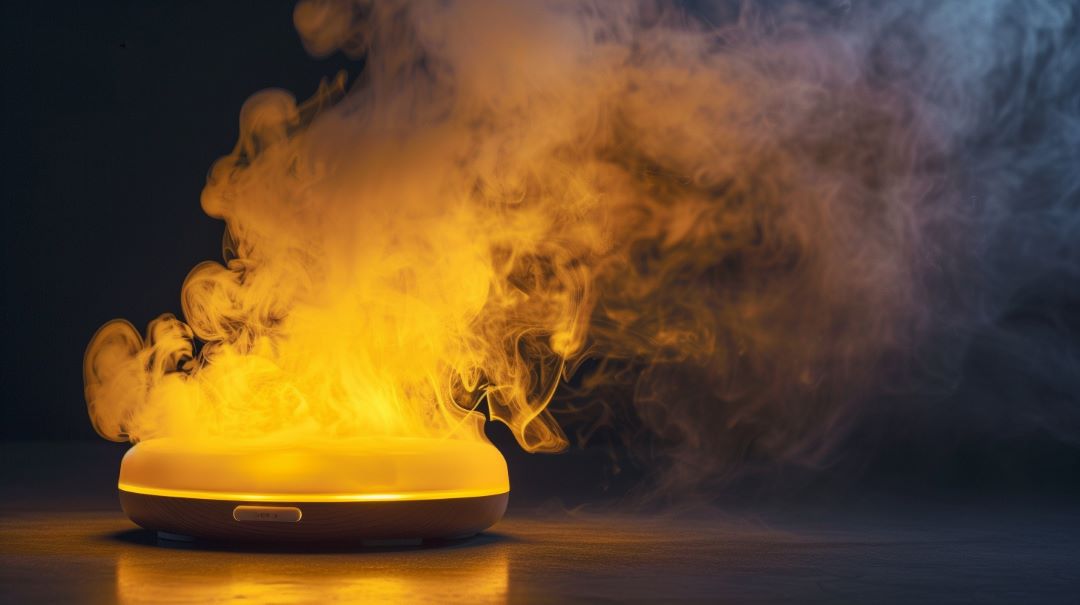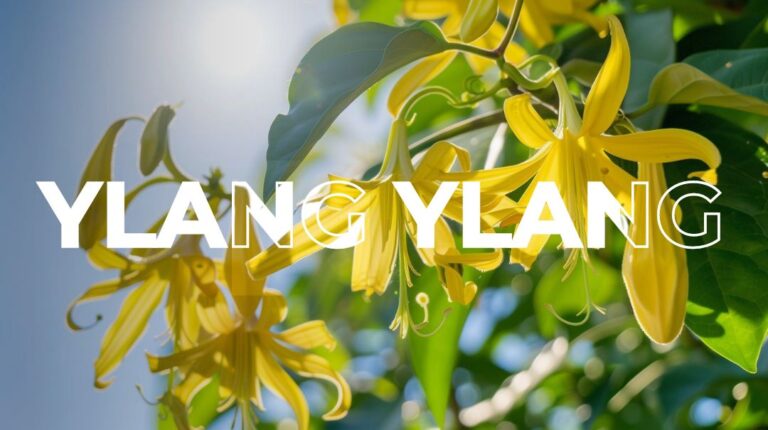Have you ever wondered what ylang-ylang smell like? People often describe the scent of this exotic flower as rich floral with tangy undertones. But is there more to ylang ylang’s fragrance than meets the eye? Let’s dive into the world of ylang ylang and explore its unique aroma.
Key Takeaways:
- Ylang ylang is a yellow, star-shaped flower that grows on the canaga tree.
- People describe its scent as rich, floral, sweet, and fruity with tangy undertones.
- Many perfumes and scented products often associate ylang ylang with femininity.
- The flower’s name, derived from the Tagalog word “ilang,” adds to its allure and exotic nature.
- Stay tuned to learn more about the origins, history, and benefits of ylang ylang!
What is Ylang Ylang?
Ylang ylang is a yellow, star-shaped flower that grows on the cananga tree, a tropical evergreen tree native to South Asian countries in the Indo-Pacific region. The scientific name for the tree is Cananga odorata. Ylang ylang arranges its flowers in clusters and possesses two sets of three petals. The blooms start as green and then mature into yellow, eventually turning brown with a reddish-brown base.
Ylang Ylang Blossom
The vibrant ylang ylang blossom, with its stunning star-shaped petals, exudes elegance and beauty. Additionally, Its yellow color adds a pop of vibrancy to any landscape. Also, The blossom’s delightful fragrance is as captivating as its appearance, making it a popular choice in the perfumery industry.
The History of Ylang Ylang
Ylang ylang’s history remains shrouded in mystery and speculation. Consequently, its history remains shrouded in mystery and speculation. While researchers have not well-documented its origins, various theories surround this captivating flower.
Some believe that Polynesians introduced ylang ylang to South Asia during ancient times. The flower’s alluring scent and vibrant yellow blooms may have captivated the Polynesians, prompting them to spread ylang ylang throughout the region.
Another theory suggests that ylang ylang became popular during the early stages of European colonialism. As explorers from Europe travelled to tropical destinations, they discovered the enchanting fragrance and beauty of ylang ylang flowers.
But, the commercial cultivation of ylang ylang didn’t begin until the 18th century. The primary reason for cultivating it is to extract its aromatic essential oil from the blossom. Today, the main cultivation areas of ylang ylang are Madagascar, Comoros and the Philippines.
Ylang Ylang Essential Extraction
The process known as steam distillation extracts ylang ylang essential oil from the flowers of the Cananga tree. This method harnesses the power of steam to separate the volatile compounds from the flowers and capture their aromatic essence.
During ylang ylang steam distillation, operators place fresh ylang ylang blossoms in a specialized distillation apparatus. Steam is then introduced into the chamber, causing the flowers to release their essential oils. The steam carries the volatile compounds upward, passing through a condenser where it cools down and condenses back into a liquid state.
Once operators complete the ylang ylang steam distillation process, they collect the resulting mixture of essential oil and water. Since oil and water don’t mix, the essential oil floats on top, and operators can easily separate it from the hydrosol, which constitutes the remaining water part.
Operators further process the extracted ylang ylang essential oil to remove any impurities and enhance its aromatic profile.
| Grade | Aromatic Intensity |
|---|---|
| “Extra” | Most potent and expensive |
| “First” | Highly aromatic |
| “Second” | Aromatic |
| “Third” | Mildly aromatic |
The cosmetic industry values ylang ylang essential oil for its versatile scent and employs it in various applications. It can be found in perfumes, candles, soaps, lotions, and other fragrance creations. The distinct aroma of ylang ylang adds a touch of sophistication and allure to any scent composition.
Benefits of Ylang Ylang in Aromatherapy

Therapists commonly use ylang ylang in aromatherapy for its therapeutic benefits. The use of ylang ylang in aromatherapy can have a positive impact on both the mind and body, promoting well-being and relaxation.
Therapeutic Benefits
Aromatherapy with ylang ylang can be beneficial in various ways:
- Promotes Relaxation: The aroma of ylang ylang has calming properties. It helps to reduce stress, anxiety, and tension.
- Improves Memory and Focus: Ylang ylang have cognitive-enhancing effects, helping to improve memory and concentration. It can create a focused and creative atmosphere, making it useful for studying or working on complex tasks.
- Supports Emotional Well-being: The fragrance of ylang ylang can help ease feelings of sadness or low mood. It is often used in blends for emotional support and balancing.
- Reduces Blood Pressure: Ylang ylang has a great potential to lower blood pressure. Inhaling the aroma of ylang ylang may help to relax the body and reduce hypertension, promoting cardiovascular health.
Using Ylang Ylang in Aromatherapy Products
Various aromatherapy products commonly contain ylang ylang, including:
- Scented Candles: Ylang ylang scented candles create a soothing ambience and fill the room with its exotic fragrance. They are perfect for setting a relaxing mood for meditation or unwinding after a long day.
- Diffusers: Users can use ylang ylang essential oil in diffusers to disperse its fragrance into the air, creating a tranquil and stress-relieving atmosphere. Users can combine it with other essential oils for a personalized aromatic experience.
If you’re looking to experience the therapeutic benefits of ylang ylang, consider incorporating it into your daily self-care routine with the help of aromatherapy products.
| Therapeutic Benefits of Ylang Ylang in Aromatherapy | Evidence/Base |
|---|---|
| Promotes Relaxation | Studies suggest that ylang ylang aroma has a calming effect on the nervous system and can reduce anxiety and stress. |
| Improves Memory and Focus | Research has shown that inhalation of ylang ylang aroma can improve cognitive performance and enhance focus and memory. |
| Supports Emotional Well-being | Ylang ylang fragrance is known to have mood-balancing properties and can uplift the spirits. |
| Reduces Blood Pressure | Some studies suggest that ylang ylang inhalation can help lower blood pressure, potentially aiding in the management of hypertension. |
Popular Perfumes Featuring Ylang Ylang Fragrance
Ylang ylang is a crucial ingredient in many coveted women’s perfumes. Here are some women’s fragrances that highlight ylang ylang:
- Good Girl Blush
- Coco Mademoiselle
- Pure XS for Her
- Chanel No 5
- Black Orchid
These perfumes exhibit the refreshing and floral essence of ylang ylang. They craft alluring scents that captivate both women and men.
In conclusion, if you’re drawn to the feminine allure of ylang ylang fragrance, a plethora of options awaits. Chanel, Tom Ford, Carolina Herrera, Paco Rabanne present a diverse array of perfumes.
How to Pronounce Ylang Ylang
In this section, I will explain the pronunciation of “ylang ylang” and delve into the origin of its name.
The correct pronunciation of “ylang ylang” is “e-lang e-lang.” The name may seem unusual, but it has its roots in the Tagalog language, specifically the word “ilang.” In Tagalog, “ilang” means “wilderness,” which refers to the way the ylang ylang flowers hang and flutter in the wind, creating a sense of untamed beauty.
Some sources claim that the name “ylang ylang” also translates to “flower of flowers,” adding to its allure and exotic nature. Yet, this translation is a mistranslation. Besides, the name captures the enchanting and alluring qualities of this extraordinary flower.
Ylang Ylang Name Origin
As observed in the table above, we can trace the origin of the name “ylang ylang” back to the Tagalog language, specifically the word “ilang.”This connection to the wilderness and the way the flowers hang and flutter adds to the mystique and allure of ylang ylang. Although some claim other translations, such as “flower of flowers,” experts consider these translations inaccurate or misinterpretations.
Ylang Ylang Candle Scented Candle
Ylang ylang scented candles are a popular choice for those seeking a luxurious and relaxing ambiance. The exquisite fragrance of ylang ylang adds an exotic touch to any space, creating an atmosphere of tranquility and indulgence. Combining rich, floral, and slightly spicy notes, the ylang ylang scent is captivating.
Known for its versatility, ylang ylang blends easily with other fragrance notes. This makes it a prized ingredient in the perfume industry.
When it comes to ylang ylang scented candles, there is an plenty of options to choose from. Many renowned candle brands offer ylang ylang scented candles that infuse your space with a warm and inviting aura. One such standout is the “Lady Day” Luxury Candle from the Harlem Candle Company. This exquisite candle uses ylang ylang as a base note, showcasing the vibrant and full-bodied aroma of this enchanting flower.
FAQ
How does ylang ylang smell like?
Ylang ylang has a captivating and exotic aroma that is often described as rich, floral, sweet, and fruity with tangy undertones. It has hints of custard, jasmine, banana, neroli, and honey. The fragrance is tropical and romantic, with a refined and sultry quality.
What is ylang ylang?
Ylang ylang is a yellow, star-shaped flower that grows on the canaga tree, a tropical evergreen tree native to South Asian countries in the Indo-Pacific region. The flowers are known for their captivating fragrance and are often used in perfumes and scented products.
What is the history of ylang ylang?
The history of ylang ylang is not well-documented, but it is believed to have been spread throughout South Asia by Polynesians during ancient times. It became popularized during the early stages of European colonialism, and commercial cultivation began in the 18th century for its aromatic essential oils.
How is ylang ylang essential oil extracted?
Ylang ylang essential oil is extracted from the flowers of the canaga tree through a process called steam distillation. Steam is used to vaporize the volatile compounds in the flowers, which are then condensed and collected as essential oil. There are different grades of ylang ylang essential oil, with the most potent and expensive being the “Extra” grade.
What are the benefits of ylang ylang in aromatherapy?
Ylang ylang is commonly used in aromatherapy for its therapeutic benefits. It is believed to help improve memory and thinking skills, create a focused and creative environment, promote relaxation, lower blood pressure, reduce anxiety, and enhance romantic experiences.
How is ylang ylang pronounced?
Ylang ylang is pronounced as “e-lang e-lang.” The name is derived from the Tagalog word “ilang,” which means “wilderness” and refers to the way the flowers hang and flutter in the wind.
What is our favorite ylang ylang candle?
Our favorite ylang ylang candle is the “Lady Day” Luxury Candle from the Harlem Candle Company. It features the vibrant and full-bodied aroma of ylang ylang, creating a warm and inviting atmosphere.
